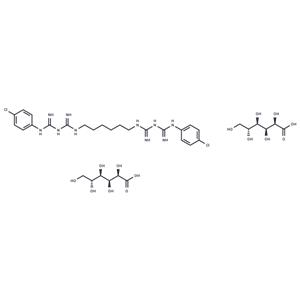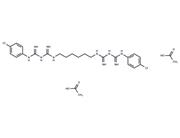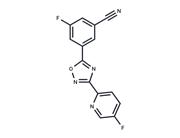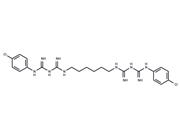| Name | Chlorhexidine digluconate |
| Description | Chlorhexidine digluconate is a broad-spectrum antiseptic and disinfectant with broad-spectrum antimicrobial activity, inhibits both Gram-positive and Gram-negative bacteria, induces necrosis and apoptosis, and can be used in the study of bacterial infections. |
| In vitro | Chlorhexidine digluconate exhibits dose-dependent and time-dependent effects on Chinese hamster ovary (CHO) cells (P < 0.05). As the concentration of Chlorhexidine digluconate increases, the mode of cell death shifts from apoptosis to necrosis: Chlorhexidine digluconate (0.00005%, 0.0001%, 0.0005%; 1 hour) induces approximately 1.62%, 5.51%, and 5.47% apoptosis, while the percentages of cell necrosis are 2.38%, 8.62%, and 22.50%, respectively.[1]. |
| In vivo | Compared to mice in group D receiving only saline lavage, a single intraperitoneal injection of Chlorhexidine gluconate (0.05%, 0.025%) significantly reduces the incidence of intra-abdominal abscess formation after lavage surgery. There is no significant difference in the incidence of gross adhesions between groups of mice that have or have not undergone surgery[2]. |
| Storage | Pure form: -20°C for 3 years | In solvent: -80°C for 1 year | Shipping with blue ice/Shipping at ambient temperature. |
| Solubility Information | DMSO : 30 mg/mL (33.42 mM), Sonication is recommended.
H2O : 80 mg/mL (89.11 mM), Sonication is recommended.
|
| Keywords | Chlorhexidine digluconate | Apoptosis | Antibiotic |
| Inhibitors Related | Neomycin sulfate | Cysteamine hydrochloride | Adipic dihydrazide | Sulfamethoxazole sodium | Terbinafine hydrochloride | Metronidazole | Copper(Ⅱ) Sulfate | Doxycycline | Tributyrin | Alginic acid | Dextran sulfate sodium salt (MW 5000) | BES |
| Related Compound Libraries | Apoptosis Compound Library | FDA-Approved & Pharmacopeia Drug Library | Bioactive Compound Library | Approved Drug Library | EMA Approved Drug Library | Antibiotics Library | Drug Repurposing Compound Library | Anti-Bacterial Compound Library | FDA-Approved Drug Library | Immunology/Inflammation Compound Library | Bioactive Compounds Library Max | Anti-Infection Compound Library |

 United States
United States






